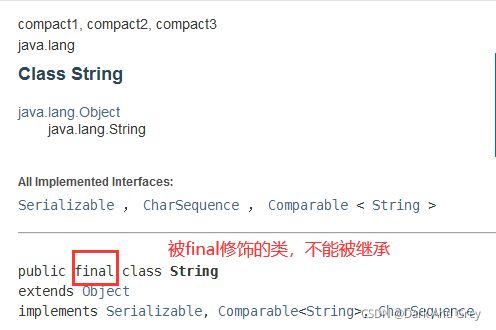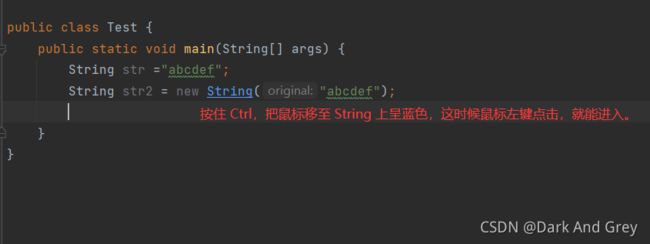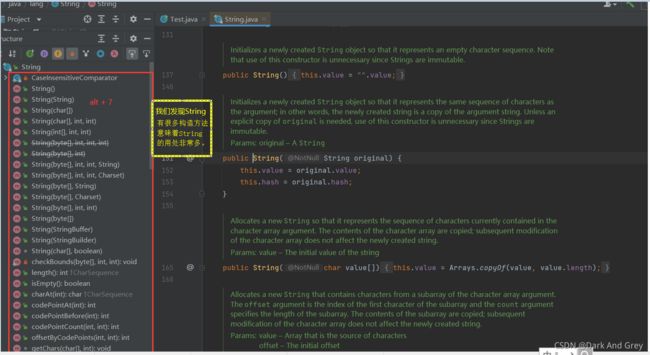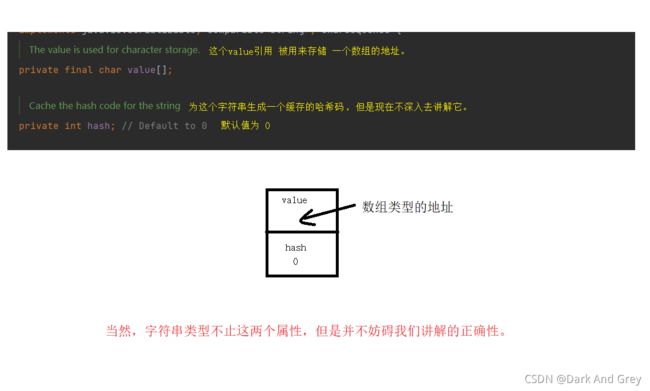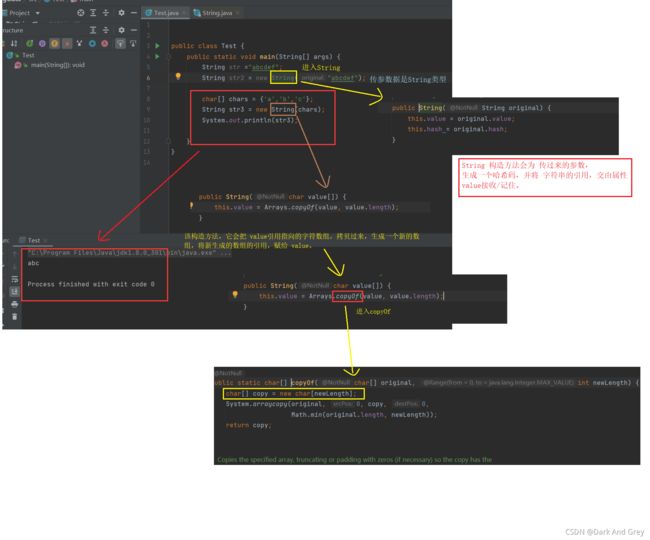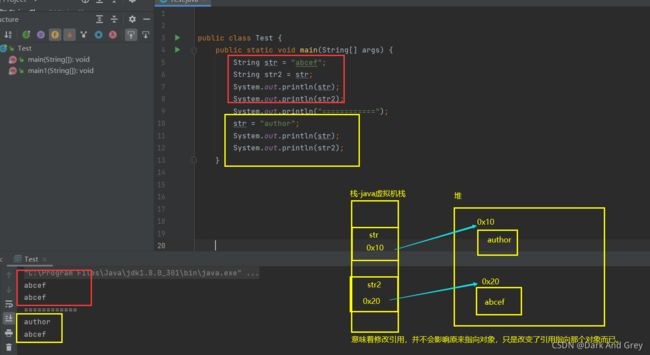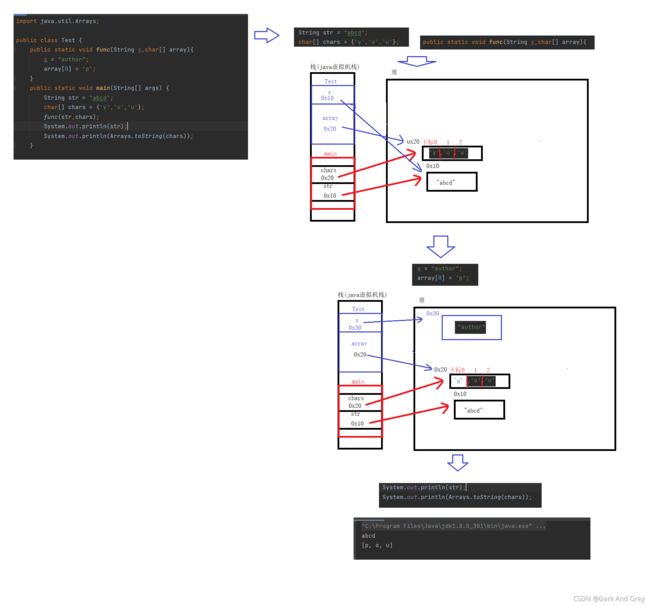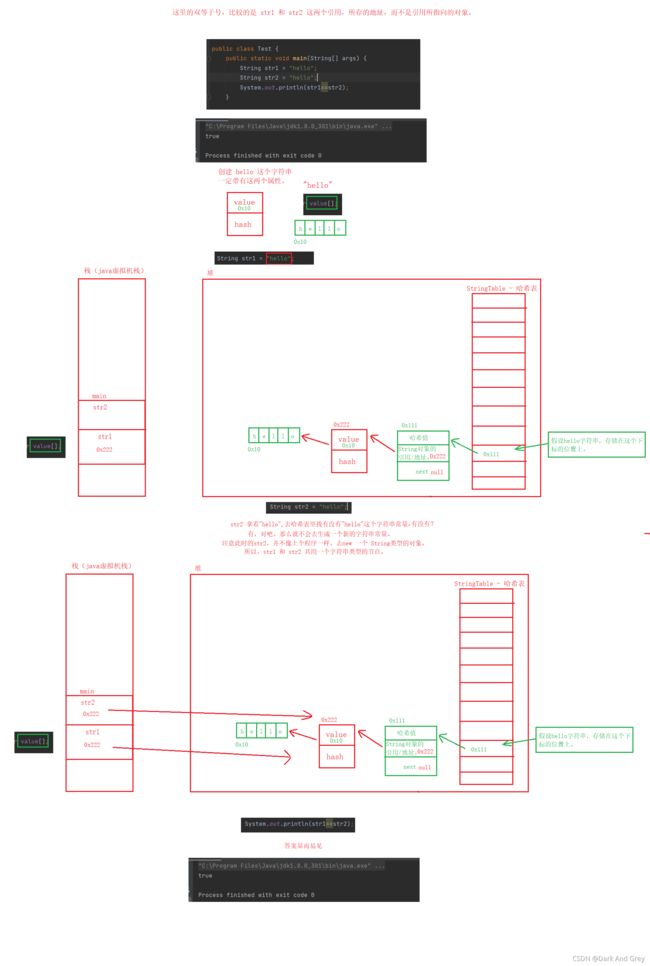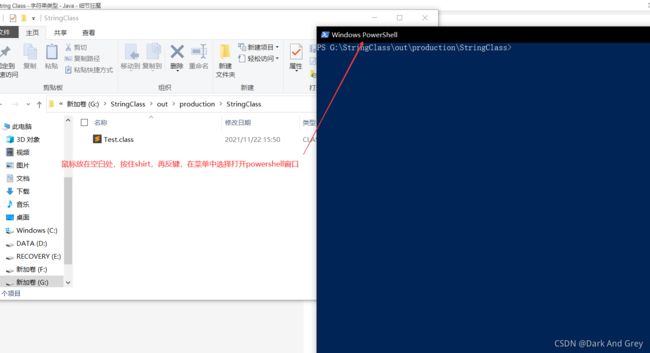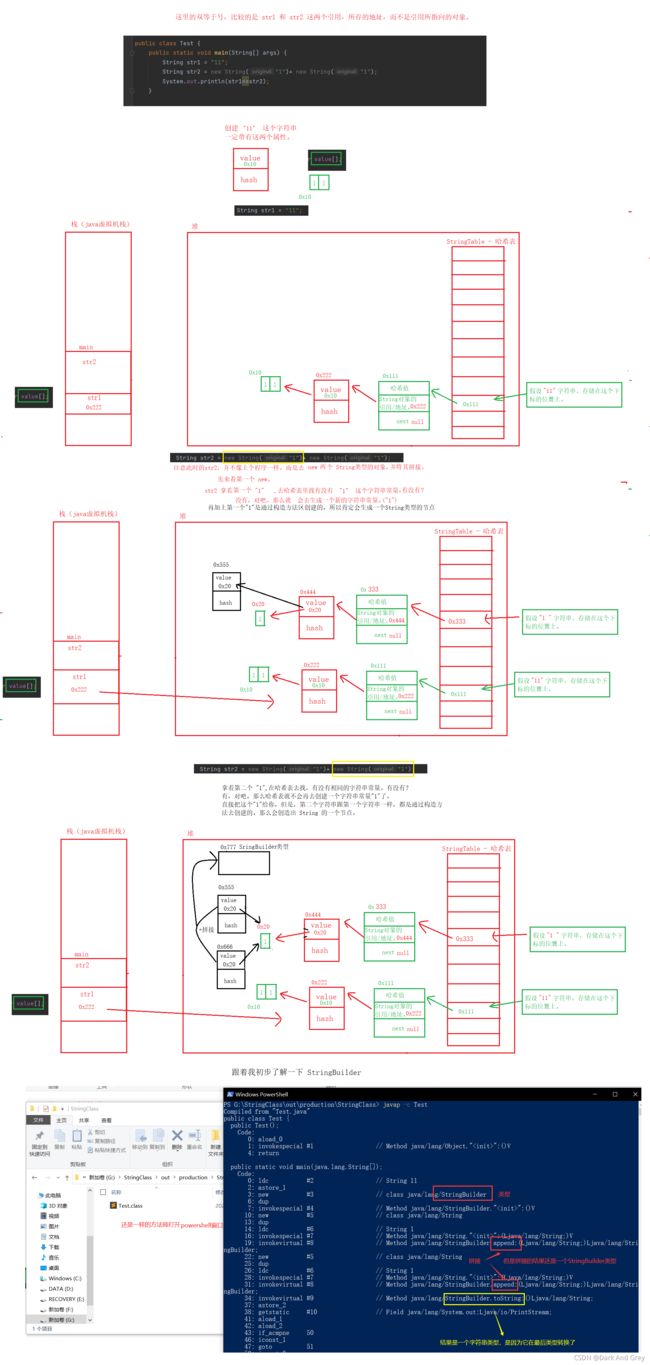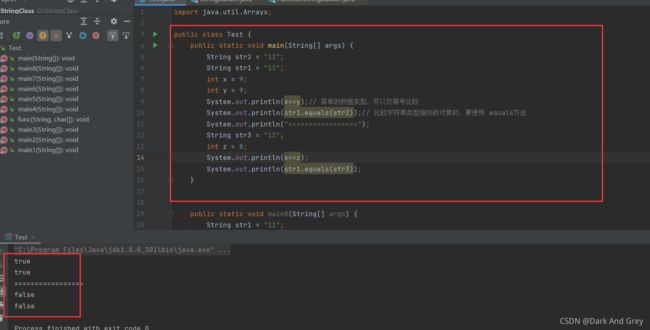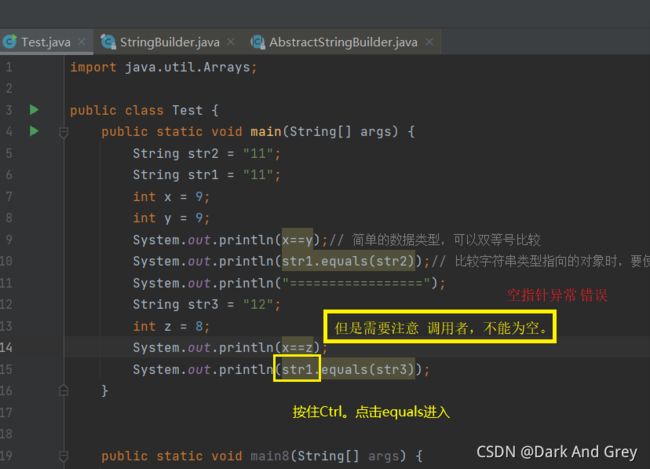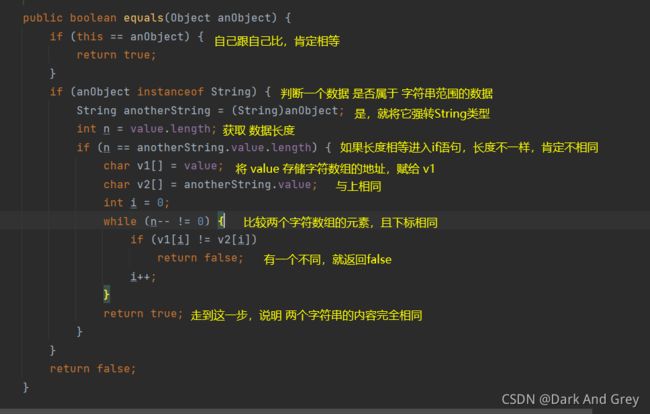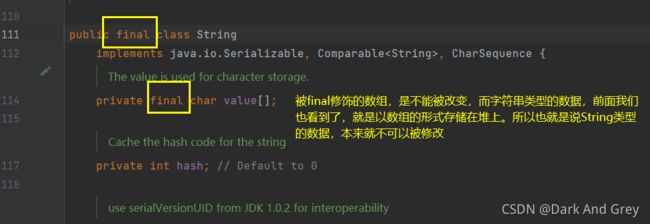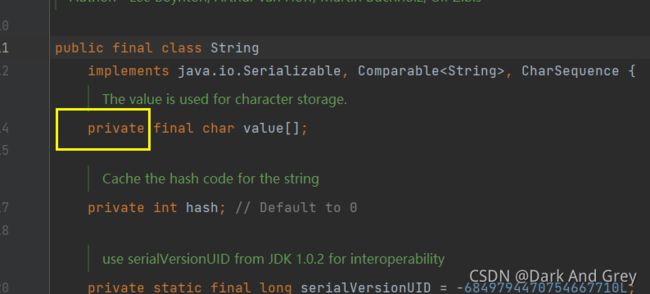String Class - 字符串类型 - 上半部分讲解 - Java - 细节狂魔
文章目录
- 前言
- 什么是字符串?什么是字符?
- 注意问题:
- 创建字符串
-
- 第一种:直接赋值
- 第二种: 调用构造方法进行构造对象(就是去new‘一个)
- 第三种:
- 了解字符串类型
-
- 根据上图,我们发现对于字符串来说,有两个属性,一个是char 类型的 value数组(此时这个数组,只是一个变量【引用类型】,没有给这个数组,分配内存。也没有new)。一个是 哈希码。
- 注意事项
-
- 例题一
-
- 效果图
-
- 附图
- 例题2: 将例题1中的 str,重新赋值会不会影响 str2的输出结果?
- 在上面两个例题中,我们需要搞懂:字符串常量是不能被改变的
-
- 下面,我们来更深层次的分析一下为什么字符串不能被修改
-
- 实例1
-
- 附图
-
- 结论:
- 实例2
-
- 效果图
- 附图
- 实例3
-
- 效果图
- 附图
- 实例4
-
- 效果图
- 附图
- 实例5
-
- 效果图
- 实例6
-
- 效果图(很明显答案是false,一个完整,一个拼接。两者肯定不同)
- 附图(底层分析)
- 实例7
- 实例7(特别版)
-
- 效果图
- 附图
- 字符串比较
-
- equals
- 拓展
- 在Java中,new String类型数据的时候,是不会存在内存重叠的情况,在Java中,字符串是一个对象,而我们new String 对象时,是产生一个新的对象,如果产生的对象是一样的,那还叫新对象??
- String 类型的数据不可变
- 数组的整体赋值 ,在Java中,只有一次机会,就是在定义数组的时候。
-
- 例子1
- 例子2
- 例子3
- 特殊引用
- 字符串拼接
-
- 附图
- 特殊:String 类型的数据,可以通过反射修改
前言
字符串:
在C语言里面 是 没有字符串类型的!
但是,在 Java 和 C++ 里,有字符串类型【String】
什么是字符串?什么是字符?
使用双引号,且双引号中包含任意数量的字符【“abcdef”,“a”】,就是字符串。
使用单引号,且单引号中,只包含一个字符【‘a’,‘强’】,就是字符。
注意问题:
创建字符串
创建方法与创建数组,几乎一样。
第一种:直接赋值
第二种: 调用构造方法进行构造对象(就是去new‘一个)
第三种:
public class Test {
public static void main(String[] args) {
char[] chars = {'a','b','c'};
String str3 = new String(chars);
System.out.println(str3);
}
}
了解字符串类型
根据上图,我们发现对于字符串来说,有两个属性,一个是char 类型的 value数组(此时这个数组,只是一个变量【引用类型】,没有给这个数组,分配内存。也没有new)。一个是 哈希码。
这里先给大家打个底,后面,我会详细讲解.。
我们先来搞懂String的对象(通过创建字符串的第三种方法)
String 常用的构造方法就是数组
注意事项
“hello” 这样的字符串字面值常量, 类型也是 String.
String 也是引用类型. String str = “Hello”; 这样的代码内存布局如下
^**
例题一
public class Test {
public static void main(String[] args) {
String str = "abcef";
String str2 = str;
System.out.println(str);
System.out.println(str2);
}
}
效果图
附图
例题2: 将例题1中的 str,重新赋值会不会影响 str2的输出结果?
在上面两个例题中,我们需要搞懂:字符串常量是不能被改变的
例如: String str = “abcd”; 通过引用 str 去将 字符串"abcd" 修改成 “gbcd”.
答案是做不到的,因为被双引号引起来的是字面值常量,常量是不能被修改的。
例题2中,str = “author”; 这句代码是将str重新指向一个新的对象(修改str的指向),而不是将原来的字符串对象修改成author。
下面,我们来更深层次的分析一下为什么字符串不能被修改
实例1
import java.util.Arrays;
public class Test {
public static void func(String s,char[] array){
s = "author";
array[0] = 'p';
}
public static void main(String[] args) {
String str = "abcd";
char[] chars = {'y','o','u'};
func(str,chars);
System.out.println(str);
System.out.println(Arrays.toString(chars));
}
}
附图
结论:
不是说 转引用 就能改变实参的值。
你要看,到底这个引用干了什么!
实例2
public class Test {
public static void main(String[] args) {
String str1 = "hello";
String str2 = new String("hello");
System.out.println(str1 == str2);
}
}
效果图
附图
实例3
import java.util.Arrays;
public class Test {
public static void main(String[] args) {
String str1 = "hello";
String str2 = "hello";
System.out.println(str1==str2);
}
}
效果图
附图
实例4
public class Test {
public static void main(String[] args) {
String str1 = "hello";
String str2 = "he"+"llo";// 注意:此时两个字符串都是常量,且在编译的时候就已经确定了是"hello"
// 简单来说像这种 直接拿两个字符串常量来拼接的,在编译时,就默认是拼接好了的,或者说 默认就是一个完整的字符串常量
System.out.println(str1 == str2);
}
}
效果图
附图
实例5
public class Test {
public static void main(String[] args) {
String str1 = "hello";
String str2 = "he";
String str3 = str1+"llo";
System.out.println(str1 == str3);
}
}
效果图
实例6
public class Test {
public static void main(String[] args) {
String str1 = "11";
String str2 = new String("1")+ new String("1");
System.out.println(str1==str2);
}
}
效果图(很明显答案是false,一个完整,一个拼接。两者肯定不同)
附图(底层分析)
实例7
实例7(特别版)
如果 我在程序中,在 str2后面加上一句代码 str2.intern(); 呢?
intern() 的作用:将它的调用者,手动入池。
public class Test {
public static void main(String[] args) {
String str2 = new String("1")+ new String("1");
str2.intern();
String str1 = "11";
System.out.println(str1==str2);
}
}
效果图
附图
字符串比较
如果是引用类型变量之间的比较,且使用双等号来比较的话,比较的就是引用变量存储的地址。相信大家应该明白,上面的例题就是这样比较的。
equals
语法 调用者.equals();
如果调用是引用类型的数据,就需要注意,调用者不能空引用/空指针。防止出现空指针异常错误
拓展
在Java中,new String类型数据的时候,是不会存在内存重叠的情况,在Java中,字符串是一个对象,而我们new String 对象时,是产生一个新的对象,如果产生的对象是一样的,那还叫新对象??
String 类型的数据不可变
数组的整体赋值 ,在Java中,只有一次机会,就是在定义数组的时候。
例子1
例子2
例子3
特殊引用
字符串拼接
;public class Test2 {
public static void main(String[] args) {
String str = "hello";
str =str + " world";
str+="!!!";
System.out.println(str);
}
}
附图
特殊:String 类型的数据,可以通过反射修改
还是上一个程序,如果我非要把字符串"abcde"的 a 改成 g 呢?
可以,前面我们也看到,String类型的数据,是数组的形式存储在对上,既然是数组,那么我们可以通过下标去修改它,
但是问题是 value 的权限是private 是 私有的
所以,即使我们拿到了对象,都拿不到value的
但是 反射 就可以走到,反射的功能异常强大。
反射 是什么?
举一个很形象的例子:
我们每次坐地铁,我们所带的行李箱,都需要进过安检,了解过的都知道,安检的机器,会发射一中光谱的曲线,通过反射,就能知道我们的行李箱中装了什么东西。从这里就体现出了 “反射” 的 概念
这里是类比一下, 通过"反射"。我们能看到类里面存储的一些属性,哪怕是私有的,又或者是上锁了。我都能看到,
也就是说:通过反射,我们能获取其中所有信息。
其实 反射就是最大bug,用得好,那叫一个nice,用的不好,那叫一个难受。
